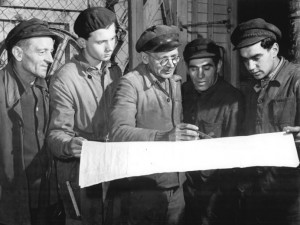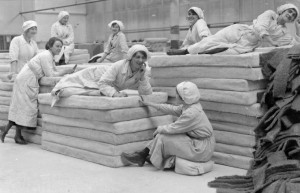
In the previous post I talked about how to have a successful plant tour and how to get the most information out of the visit. Today’s post shares the tricks of the trade on what things the plant does NOT want you to know about.See through the ruse during a plant tour and discover how good the plant really is.
Update: Due to popular demand i have added a Lean Shop Floor Visit Checklist.
While this post could be used by plant managers as instructions to misguide their visitors, in my experience the plant managers know this anyway. This post is for Very Important People—simply called bigwigs below—to understand how they may be manipulated, as well as how they can counteract these manipulations. As such, this post may contain a trifle of sarcasm (okay, it contains a lot). Proceed with caution.
Naturally, the people of the plant want their plant to look good. For that reason, they are very hesitant to reveal the truth about the plant. This is especially the case if you’re a high-ranking manager (the bigwig) trying to decide where to invest your money or which plant to close. But even for normal visitors, looking good may help sell products, keep the plant’s reputation up, and retain business. Here are a few tricks plant managers use to make sure their visitors know only what they’re supposed to know.
Paint!

In large corporations, a flurry of activity usually starts preceding a visit from a bigwig. These activities are not aimed at making the plant good, but at making the plant look good. This means painting the walls, cleaning machines and tools, and so on.
- Renovate bathrooms along the carefully planned route (the only time I ever see a bathroom renovated on the shop floor is for a bigwig visit).
- Paint walls. Bigwigs surely must believe every plant smells like fresh paint.
- Clean everything spotless. I have seen countless operators and supervisors spending hours on their knees cleaning machines for a bigwig visit.
Hide!

Anything the bigwig is not supposed to be seen is hidden away.
- Plan the route for the tour carefully to avoid any troubled areas.
- Close doors and access ways that are usually open for transport to hide the mess behind them.
- Put up temporary or permanent screens or walls to hide whatever is behind, lest the bigwig’s eyes be fouled by a glance at a garbage bin area.
Be Busy!

Of course, when the bigwig visits, the machines should be running. This should be obvious, but I was part of quite a number of visits where the machines to be visited were down. Of course, a breakdown can happen anytime, but if the downtime is due to a scheduled maintenance, a planned downtime, or simply an absent operator or missing material, then there are plenty of ways to prevent this.
Furthermore, if there is a shortage of material for the product to be observed, I have also seen complete products disassembled before the visit just to have something to assemble when the bigwig comes around.
Distract!

After painting, hiding, and other measures to create a selective version of the truth, the most important measure is to distract the bigwig. Occupy his mind otherwise before he can see something he shouldn’t. Popular measures are:
- Flood the bigwig with information. Not one, not two, but at least three people from the plant join the tour so that at every moment the bigwig has to listen to someone or something. Of course, the information given does not contain anything negative or critical. The possible exceptions are some pseudo problems in order to not appear perfect and hence suspicious.
- Focus the tour of the bigwig on good areas, go there in detail of all the good things, and glance over or completely avoid anything problematic. It is best to not even go there.
- Make sure the bigwig doesn’t talk to anybody who may reveal nasty truths. Shop floor operators should be instructed accordingly, and should refer any questions to a manager who knows what to say and what not say. However, in my experience this is rarely a risk, since bigwigs usually don’t talk to little people anyway.
- Finally, get the bigwig away from the shop floor as soon as possible and into a conference room where you can show him the slides that the plant management spent the better part of the last two weeks preparing and polishing. If the bigwig insists on a shop floor visit, simply print out the slides and put them on a board on the shop floor. He’ll think he’s doing a shop floor visit, but he still gets the filtered truth through slides.
Do all of the above and the bigwig will surely have no clue about the true situation of the plant. Unless, of course, he knows …
… how to see through the ruse!
If you’re a very important person (the bigwig) who not only wants to show his presence but really wants to understand the plant, there are a couple of tricks to see through the ruse. First of all, if you have not yet done so, read my post on how to make your plant tour a success. And then follow the guidelines below:
- Arrive unannounced. If the plant has time to prepare, they will. Countless hours will be spent both in the office and on the shop floor to prepare your visit. Budgets will be reallocated for fresh paint and new toilet bowls. Save your corporation the effort and money and visit unannounced or on very short notice if possible.
- Don’t stick to the tour. Decide yourself where you want to go, look behind closed doors, and deviate from the carefully prepared route. Also, don’t hesitate to watch an area for ten minutes or more. It’s amazing what you see when you look at a process for a longer time.
- Ignore presentations in preference of shop floor time if you can. And by shop floor time, I mean real shop floor time, not just a presentation on the shop floor.
- If possible, also ignore the presenter or guides. Rather than trying to listen to official talk, focus on the shop floor as described in my previous post. I find a guide—even one with best intentions—often more distracting than helpful. If you can go on your own, then do so. As a compromise, do one part of the tour with a guide to get the basics and then visit the shop floor again yourself.
- Talk to people on the shop floor. Not only do they know the situation best, they often don’t hesitate to give you a true honest opinion. Of course, keep in mind that their viewpoints are not necessarily the viewpoints of the enterprise, but their information is useful nevertheless.
Do all this and you should get a much better view of the true situation than you’re supposed to have. Don’t just take over the official plant opinion. Make up your own mind! Now, go out and improve your Industry!

Good stuff. I’ve experienced it many times where the area lead hands everyone a couple cans of spray paint to paint stuff to prep for the big boss’s visit in a couple days or an upcoming event. Never mind the fact that if the surface isn’t prepared properly, the paint won’t last for more than two weeks.
Talking to the people who work in the area is great advice, but there are a couple caveats to it. First, no one in their right mind will have anything negative to say when the bigwig is always escorted around by the plant manager and three supervisors. Then there’s the matter of people skills. Since bigwigs typically ignore ordinary workers, you are not always going to have someone open up right away about the issues that happen on the floor.
Finally, if you’re the bigwig, strongly consider the good old chalk circle exercise. It’ll take time, but even a couple hours can reveal less than obvious problems. And it takes care of the look busy ruse, as well. Very few operators can sustain being busy 100% of the time for very long, and even those who can will be forced to wait whenever the preceding processes aren’t feeding them the work :). And if you can handle the work, feel free to volunteer to work a shift in an area.
🙂 Almost everybody on the shop floor has such stories of painting and cleaning for the big guy.
As for talking to people, you would be surprised how many shop floor workers (not managers) luckily lack “diplomacy” and say it as it is. Of course not everybody is outspoken, but I very often got a feeling about the real situation by talking to them.
I find that standing and watching for five minute intervals at different locations during a tour provides an opportunity to observe for systems, processes and flow. Flow of information, flow of labor resources, flow of material, etc. Also flow of information and exchanges or hand-offs between process owners in the shop. You can get a feel for a spaghetti diagram and work up your appetite for the donuts and pastries awaiting you back in the conference room you are being herded back to for more powerpoint finery. 🙂